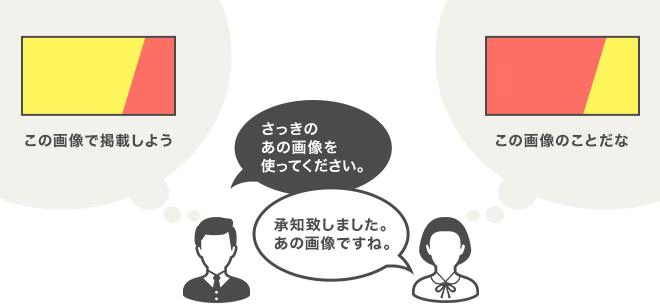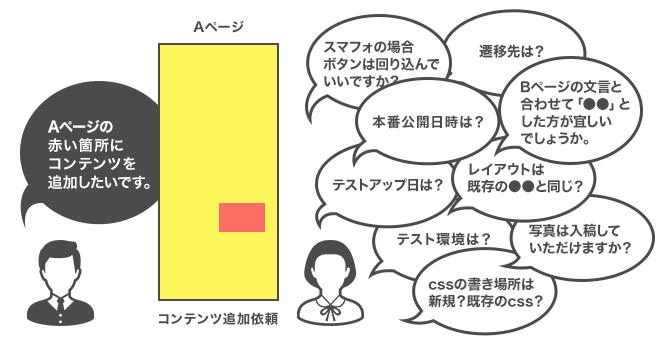こんにちは。クリエイティブ部 ディレクターの加倉井です。
日頃、お客様とのやり取りをメインにしておりますが、実は、説明が下手なうえに、テンパリ症。苦手教科は国語と英語。ディレクターに不向きなアビリティです。
案件を進めるうえで不明点があれば、常々お客様に確認をとっていますが、聞き方、伝え方に悩むことが本当に多くありました。そこで今回は、この3年私が悩みに悩みぬいて、試行錯誤しながら身につけた「聞き方、伝え方で心がけている5つのこと」について、ご紹介したいと思います。
1. ネガティブな事象をポジティブに変換する
案件で心配な点があれば、お客様に相談をして方向性を確かめると思いますが、そんな時、ついネガティブな聞き方になっていませんか?ネガティブになりがちな物事を、ポジティブに変換する方法について、事例を元にご紹介します。
事例1 :要望内容や入稿物に対して「お願い」をしたい時
サイトのトンマナを統一、サイトのイメージ担保、ページのパフォーマンスなど、理由はいろいろありますが、お客様からの指示内容に対して「お願い」したい時があります。
例えば、「この写真を掲載してください。」と送られてきた写真が、規定のサイズに満たず拡大するとぼやけてしまう場合や、被写体の位置がレイアウト的にしっくりこない場合に、どう伝えるのか。

例:拡大するとぼやけてしまったり、背景が足らず被写体を中心に合わせることが出来ない場合。
折角ご準備いただいた写真をお戻しするのは申し訳ないのですが、写真や図のクオリティを落として掲載するのはとても勿体無いのです。(写真や図の情報量は、テキストのおおよそ10倍と言われています。)
そこで、一旦いただいた画像を当てはめて、以下のようなメールをお送りしています。
ご用意ただきました画像を当てはめさせていただきました。
規定のサイズに合わせると画質が落ちてしまいました為、
再度画像をご準備いただくこと可能でしょうか。
ご準備お時間がかかるようであれば、現状の画像にて一時進めさせていただき、
お写真確定次第の差し替えも対応可能です。
手間がかかりますが、対応出来る範囲内でお見せした方が認識が早く、納得していただきやすいです。次のご依頼があった際も画像で見ている分、記憶に残りやすく入稿物のやり取りがスムーズになります。
また、再入稿は時間がかかることも想定されます。準備で案件を止めてしまうとお客様の負担が大きく感じられる為、制作と準備が同時並行で進められるか一度検討してみましょう。
臆せず、もっとこうした方がサイトが良くなる!と思えば、前向きな言葉で納得してもらえる文面に変わっていくはずです。
事例2:短納期のため、先方の確認期間が短いことを伝える時
どんなに計画的に進めていても、突発的に発生する作業は少なくありません。自社側のリソースを調整するのはもちろんですが、お客様の確認もスピーディーに進めていただく必要があります。そんな時はどんな伝え方が良いでしょうか?
御社のご確認期間が短くなりますことご了承下さい。
これでも問題ありませんが、若干お客様にもプレッシャーかけている印象になります。そこで、魔法の言葉「ご協力のほど宜しくお願い致します。」を追記すると…。
御社のご確認期間が短くなっておりますが、
何卒ご協力のほど宜しくお願い致します。
お互いに頑張りましょう!そんな捉え方になった気がしませんか?
些細なことですがお互いに気持ちよく案件を進めるひと工夫です。
2. 「具体的に」聞く、決める
次に大切なのは「具体的に聞くこと」です。
例えば、ボタンの色1つ決める際にも、「何色にすればいいでしょうか。」と、聞き手に丸投げにせず、聞き手が明確なイメージが持てるように、具体的に聞くことが大切です。
仮にお客様から「青でお願いします。」と言われても、16進数のうち青に属する色は数千パターンとあります。極端な話、信号と同じく緑系統の色を青と呼ぶ場合もある為、以下のように参考になる色を指定して聞きましょう。
青ボタンで使用している色味でいかがでしょうか。
この時に、サイト内で使用している色や、ガイドラインに掲載されている色を指定すると、ルール的にも統一性を高めるためにも利点が多いです。色だけでなく、見出しのデザイン、動画の再生時の動き等も参考になるものを提示してみましょう。
また、お客様が「はい」「いいえ」のみで答えられるように意識して聞くと、「~の認識で宜しいでしょうか。」「~はいかがでしょうか。」など具体的な内容になります。制作物のコントロールも出来ますし、お客様の負担も軽減させる、これぞ Win-Winですね。
とは言え、経験がないと具体案は出てきません。
そんな時は先輩や同僚の知恵をお借りするのも一つの手。的外れでもいいから自分で具体案を絞りだし、先輩や同僚と相談しながら答えを出してください。
3. 「これ・それ・あれ」に要注意
2つめに共通することですが、これ・それ・あれ等の指示代名詞は具体性に欠ける為、お客様との認識をズラしてしまう要因になります。
自分:承知致しました。あの画像ですね。
対面で話すときは身振り手振りで伝わりますが、お電話やメールの場合、該当する事柄や物が複数あれば、聞き手、読み手によって「これのことだ」と誤認識する危険性があります。

無理に指示代名詞を封印する必要はありませんが、多用するのはお勧めしません。
不明点の確認時は、「どこの、いつの、どんな、なんの」など前置きをして、指しているものが特定できるように心がけましょう。指示代名詞で指示をもらった場合も、具体的に復唱しなおし、認識を合わせてください。
自分:先ほど修正した「メインがピンクの画像」ですね。
お客様:いえ、修正前の「メインが黄色の画像」でお願いします。
指示代名詞を具体的に置き換える事で、後の事故を防ぐことになります。
4. 不明点に「番号」をつける
聞きたいことや共有事項が複数ある場合は、項目ごとに番号をつけましょう。

たとえば、聞きたいことが5つあれば、以下のようにメールをまとめます。
以下5点確認事項です。
-
本番公開日はいつをご希望でしょうか。
また、テストアップ日は XX/XX を予定しておりますが、
問題ございませんでしょうか。 - 掲載するお写真は御社でご準備いただける認識で宜しいでしょうか。
- ・・・・・・・・・・・・・・・・・。
- ・・・・・・・・・・・・・・・・・・・・・・・。
- ・・・・・・・・。
番号をつけておくことで、電話で話す際にも「確認事項2番の写真につきまして~」と確認事項が明確になりますし、文面上から探すこともスムーズになります。
また、お客様からメールで返信をいただく時にも、番号に対して返信をもらうことが出来る為、以下のように端的にやり取り出来ます。
-
スケジュールについて
XX/XX 公開希望です。テストアップ日問題ございません。 -
写真について
はい。後日連携致します。 -
・・・・について
そちらでお願いします。 -
・・・・・
確認して、後日ご連絡致します。 -
・・・・・・・・
確認して、後日ご連絡致します。
番号を付けることで、お客様も自分も整理がついて認識合わせがしやすくなります。
5. ときには「言い切ること」も大事
お客様とのやり取りを重ね、ある程度理解が深まっている案件や、確認しようがない事柄については、ときに「言い切ること」も大事です。
もし、全部を聞き口調にした場合、どうなるでしょうか?。
-
本番公開日はいつをご希望でしょうか。
また、テストアップ日は XX/XX を予定しておりますが、
問題ございませんでしょうか。 - 掲載するお写真は御社でご準備いただける認識で宜しいでしょうか。
-
コンバージョンボタンはAページのデザインを
踏襲させていただいても宜しいでしょうか。 -
入稿が遅れる際は、公開日時のご相談を
させていただいても宜しいでしょうか。
上記のように全部を聞き口調で書いてしまうと、お客様はすべてに回答をする必要がでてきます。そこで、確実にわかっていることと、確認が必要なことを切り分けて記載します。
-
本番公開日はいつをご希望でしょうか。
また、テストアップ日は XX/XX を予定しております。 - 掲載するお写真は御社でご準備いただける認識で宜しいでしょうか。
- コンバージョンボタンはAページのデザインを踏襲させていただきます。
-
入稿が遅れる際は、公開日時のご相談を
させていただきますことご了承下さい。
ある程度、言い切りの言葉にした場合、その内容に不備や不都合があった項目のみ、お客様は返答をくれる為、お客様の負担を減らすことが出来ます。
ハンドリングも自分で出来きるので、案件をスムーズに進める上でも有効です。
まとめ:相手の立場になって考える
以上、5つの「聞き方、伝え方で心がけていること」をご紹介してみました。
今も私は未熟者ですが、新米だった頃は本当にひどい内容のメールばかりで、電話も一言一句メモに準備して不明点は折り返す、を繰り返していました。もちろん今も試行錯誤を重ねていますが、大事なのは「相手の立場になって考える」ことだと思います。
どうすればお客様に伝わりやすいのか、どんな聞き方をすればお客様の負荷が減るのか。一度書いた文面を、相手の立場になって読み返してみることで、より良い形で書き換えられる部分も出てくると思います。
こうすれば完璧!ということはなかなか無いと思いますが、沢山のお客様とやり取りをさせていただきながら、より良い「聞き方、伝え方」を身につけるべく、私自身も日々精進していきたいと思います。
